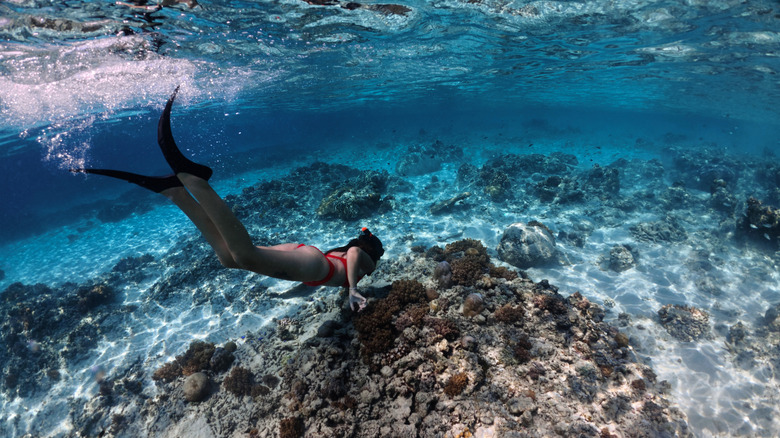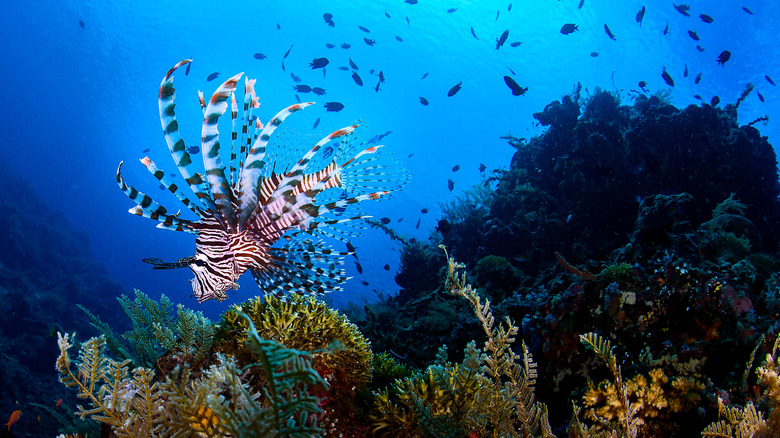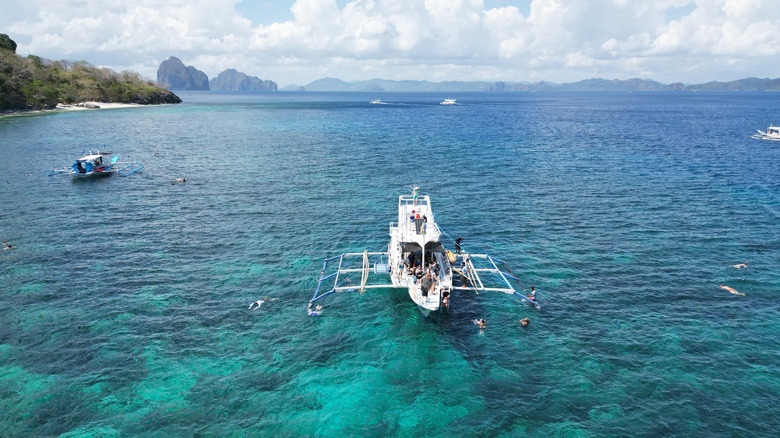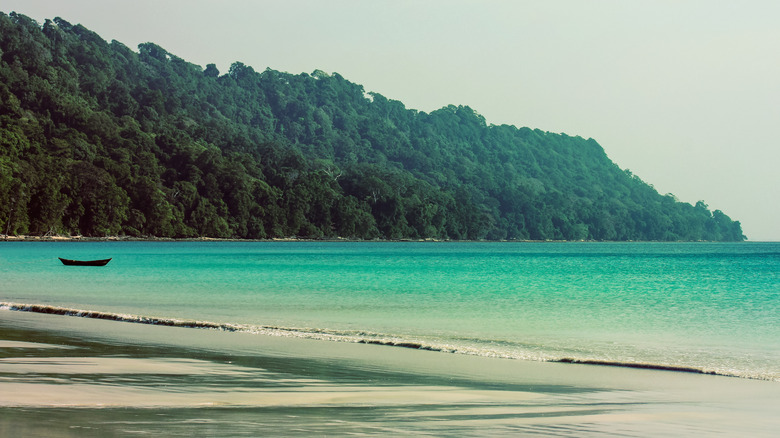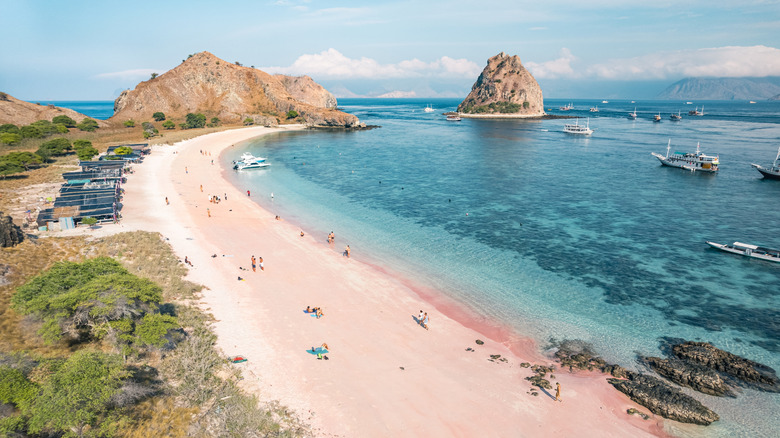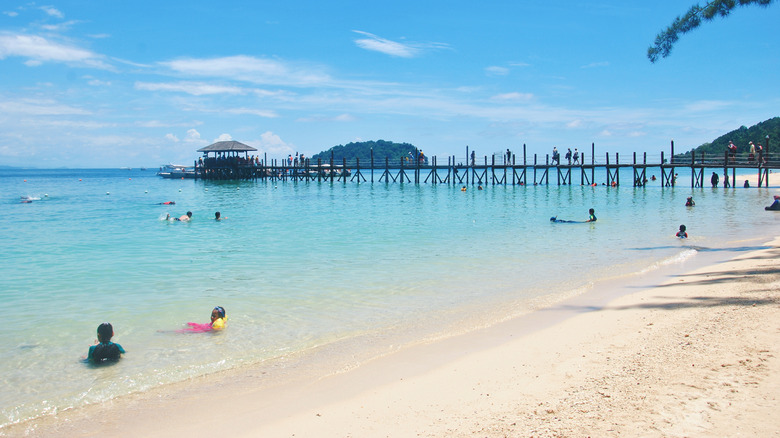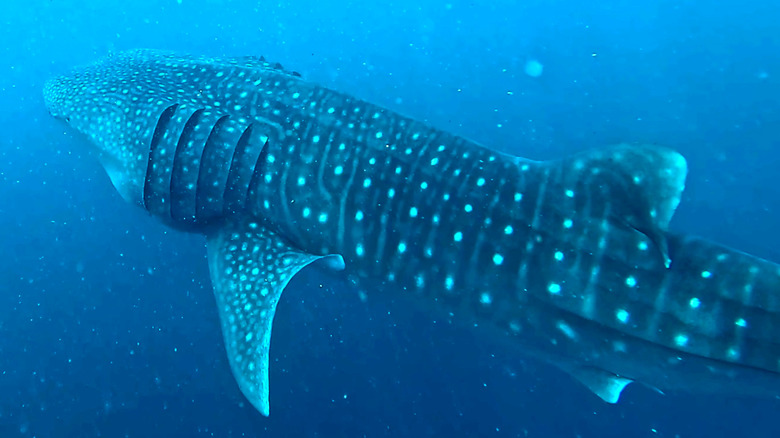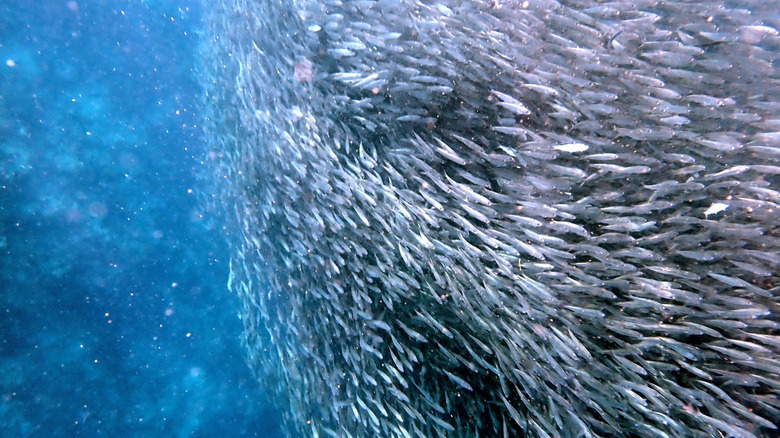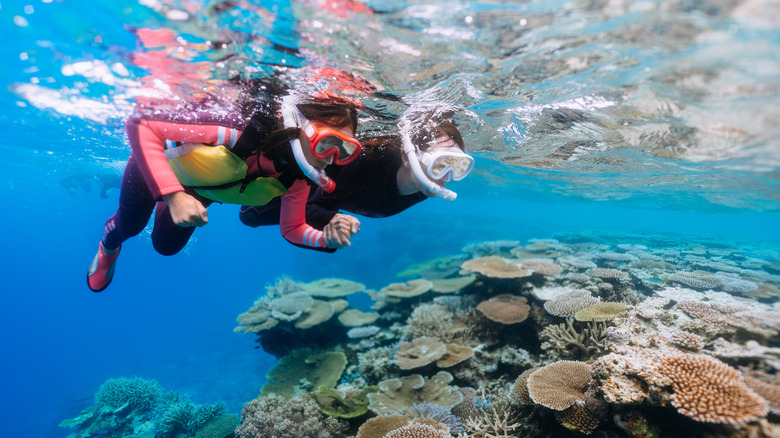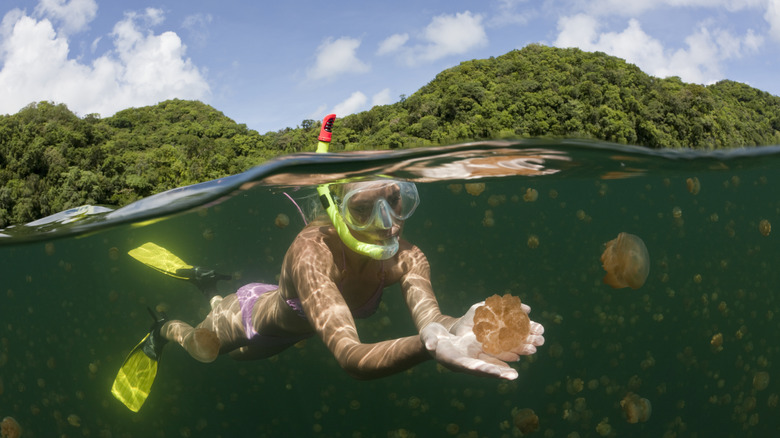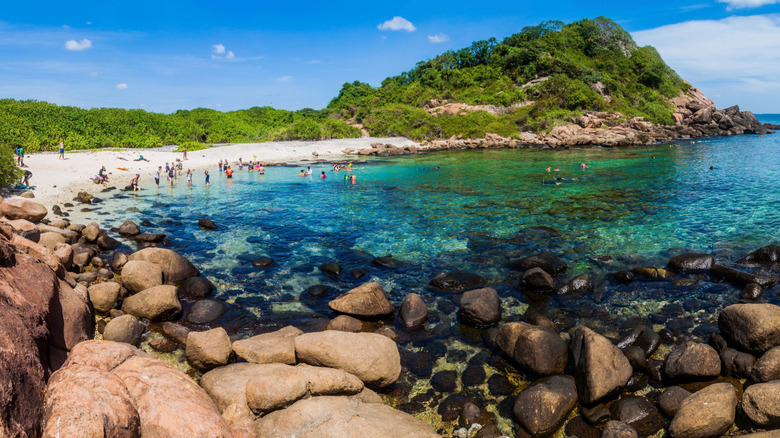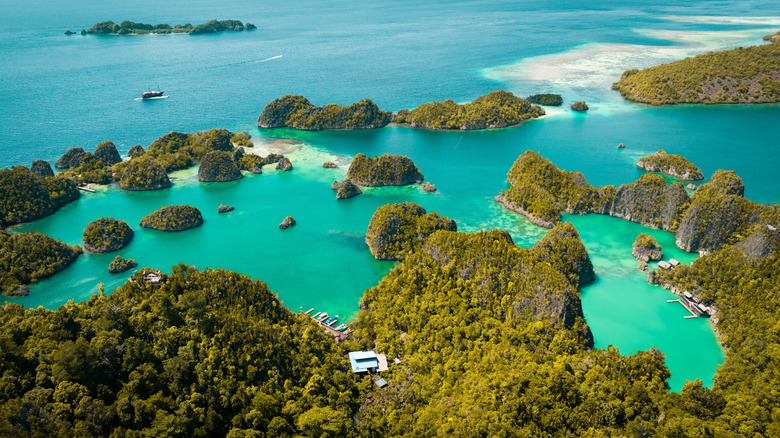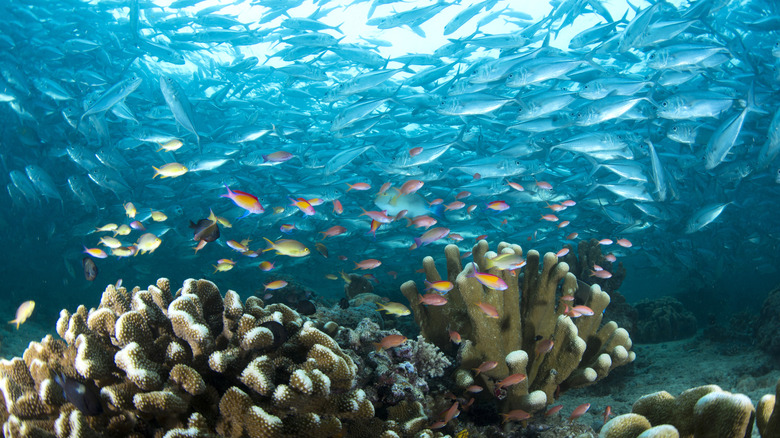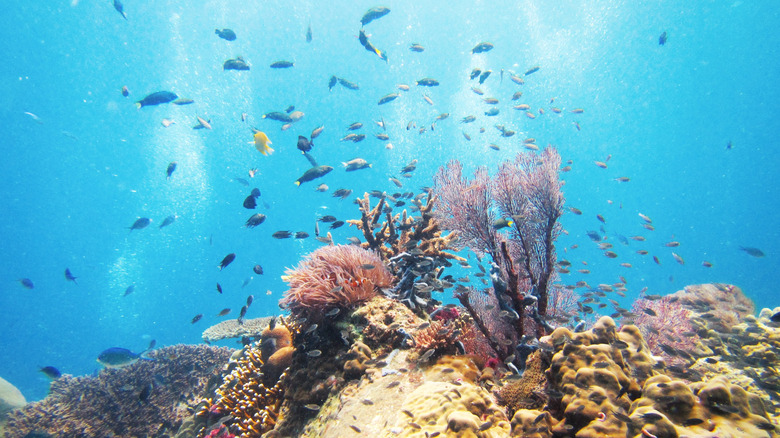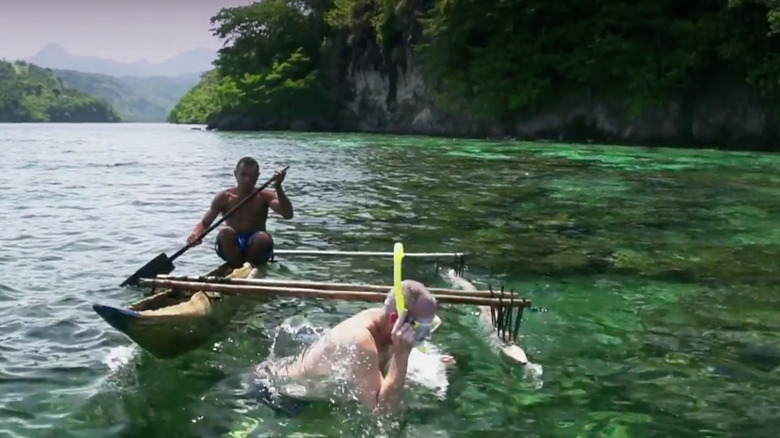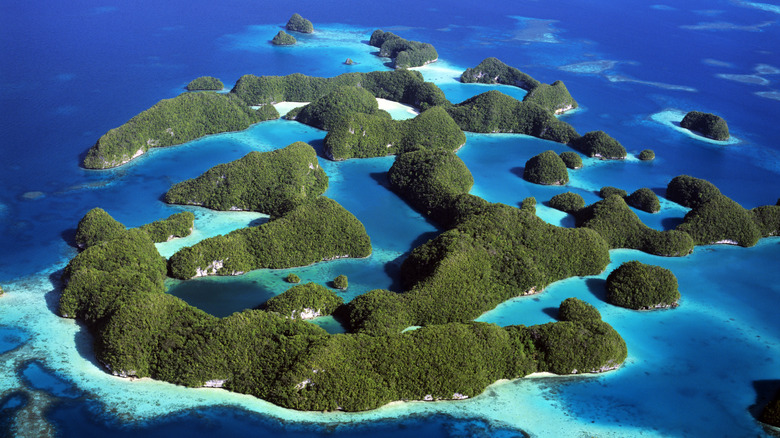14 Most Stunning Destinations For Snorkeling In All Of Asia
The largest continent in the world, and also the most populous, Asia beckons travelers with its endless catalog of sites. There are gems like the Taj Mahal, a place you should learn some details about before visiting, and the temples of Angkor Wat. This is the region with the Great Wall in China, and Japan, a nation with stunning destinations that won't break the bank. Along with all its linguistic, cultural, and physical diversity — Asia is also home to Mount Everest, a peak filled with the most interesting facts that might come as a surprise — this part of the world is also a fabulous place for snorkeling.
That is because the Coral Triangle, a vast marine tranche covering millions of square miles, and the most rich aquatic environment on Earth, stretches across large sections of Southeast Asia. Within this area, visitors are blessed with some fabulous places to experience marine life. But even in other parts of Asia, a few stunning snorkeling destinations stand out. Using blogs, and personal experience, we've put together some of the ones that you won't want to miss.
Bunaken National Park, Indonesia
This marine park off the part of North Sulawesi that looks like a whip in mid-swing was submitted to UNESCO in 2005 to be added to its World Heritage Sites list. That request, in itself, should be testimony enough of the special qualities of this part of the sea. The attraction, in addition to volcanic and coral islands, is the vast array of coral, fish, and aquatic creatures that prosper in these waters.
The park itself encompasses a handful of islands — some with accommodations that are perfect for overnight visitors — and a slice of the sea off the coast of Sulawesi, one of Indonesia's many large islands. Snorkelers can expect to see a healthy stock of marine life wherever they venture into the water. Among the bright fish that swish around the reefs are butterflyfish, sergeant majors, damselfish, and razorfish. Travelers might also see blue-spotted rays and definitely will spot a few turtles, lots of anemonefish (also known as Nemo fish), and a generous helping of sea stars.
El Nido, Philippines
Clear waters open up to healthy coral reefs on this piece of Palawan Island, one of the best islands to visit in Southeast Asia. El Nido refers to both a town and a larger region that forms part of Palawan, a long skinny isle that tilts like a slope along the western edge of the Philippines. What divers and snorkelers will find in El Nido is a marine fantasyland, where hundreds of species of fish swarm the waters, and seas that are so clear that you can see far into the distance underwater.
The diving is fantastic, and the snorkeling is equally rewarding. What tourists that venture to this part of the country will be able to witness are reef fish that include angelfish, sweetlips (thus named for their pouty mouth), colorful parrot fish, and groupers. Larger animals range from beady-eyed moray eels, to slowly gliding turtles. You can also keep a lookout for black-tip reef sharks, rays, cuttlefish, and seahorses. Coral fans will enjoy the chance to paddle in the water with more than 100 species of the aquatic life form.
Havelock Island, India
Many people still refer to this island as Havelock Island, others prefer to use its official name Swaraj Dweep. Either way, it is one of India's Andaman and Nicobar Islands, sitting far from its motherland — it is actually much closer to Thailand than to India. Whatever name you use, this secret island is a tropical paradise with a fraction of the crowds. It is also a gem of a destination for snorkelers.
Visitors planning a trip to the island can expect warm, clear, tranquil seas that are always inviting, with November through March promising the best conditions. A few places excel for travelers looking to snorkel directly from the shore and see creatures such as anemone fish, parrot fish, and seahorses wriggling around bright reefs. Elephant Beach is one of the prime stretches of sand on the island. Slide into its waters, and you might witness a turtle munching on seagrass, or crunching some coral. At Turtle Beach, the grand staghorn corals are among the lures, while Radhanagar Beach is sometimes visited by dolphins.
Komodo National Park, Indonesia
The name of this park hints at what its main attraction is — the big, bad Komodo dragon. A massive lizard with tough skin, and deadly claws, it is only found in Indonesia, with many of its numbers resident in the national park. Inscribed as a UNESCO World Heritage Site, Komodo National Park comprises three main islands (Komodo is the largest of them) and a scattering of smaller ones.
Many visitors will come here expressly to see the giant reptiles, but to miss the amazing marine life would be a travesty. Slipping into the waters around the islands, travelers might see a variety of marine creatures, large and small. These range from anemone fish made famous by "Finding Nemo," to mammoth manta rays with huge wingspans. You'll also encounter turtles, sea stars, and healthy, colorful coral reefs. One of the most incredible places to snorkel on Komodo is Pantai Merah, or Pink Beach, with plenty of fish in the water, and a beach where the sand really is tinted with a rosy hue.
Kota Kinabalu, Malaysia
Mount Kinabalu is the tallest peak in Malaysia, climbing to more than 13,000 feet above sea level. For many adventurers in Asia and beyond, mounting its summit is a bucket-list experience. Trips to the mountain usually start in Kota Kinabalu, the main city to the west, but visitors to that coastal metropolis can also head in the other direction, out to the water, for adventures of a different sort. Kota Kinabalu, commonly referred to as KK, is also the gateway to the marine riches of TARP, or Tunku Abdul Rahman Park.
The marine park encompasses five islands and plenty of open water in between, where coral reefs attract all manner of fish. Operators take snorkelers on excursions into the park from KK since the boat ride to the main snorkeling sites takes less than 30 minutes. Within the protected waters of the park, look forward to seeing moray eels, lionfish, flounders, and reef sharks.
Maldives
This nation in the Indian Ocean is a water baby's dream destination. It comprises more than 1,000 islands scattered across the seas and set in a series of atolls, like strands of jewels on a canvas of mesmerizing blue. The Maldives has some of the most incredible seas on the planet, so even if you don't snorkel, a swim there is pure bliss. This country is also where to find some of the most beautiful overwater bungalows around the world. Visitors that venture out with a mask and fins will be on the lookout for more than 60 species of coral, and hundreds of species of fish.
While snorkeling around many of the islands and atolls will be a rewarding endeavor, some sites stand out. Ari Atoll has plenty of plankton in the water, and this attracts some big creatures. Among the common sightings for seasoned travelers are whale sharks, manta rays, and hammerhead sharks. The atolls close to Malé, the capital of the Maldives, are where to find more mantas, in addition to octopus, reef sharks, and large varieties of colorful fish.
Moalboal, Philippines
This coastal area in western Cebu is home to plenty of coral. For snorkelers who like to venture out directly from the beach, Moalboal has a reef that is less than 200 feet from the shore. The reef is where to find fish, sea snakes, and of course strands of healthy coral. Beyond the reef, the sea floor drops rapidly, making it an interesting spot for free divers to explore. Another popular location to snorkel around is Pescador Island, a tiny blip in the sea that sits southwest of Moalboal.
Getting there requires a transfer on a boat and one of the main highlights is the abundance of turtles. There is also lots of coral that will have snorkelers admiring the tableau ad infinitum. Moalboal is perhaps most famously known throughout the world for its unique sardine run. The rhythmic, almost choreographed movements of gargantuan swarms of sardines, like an underwater tornado, are hypnotizing. For snorkelers, it is a natural wonder that will leave them wrapped in wonder.
Okinawa, Japan
This long, curving island is actually closer to Taiwan's capital Taipei than it is to Tokyo. Okinawa almost feels like Japan's version of Hawaii — where some Japanese islands might feel temperate, Okinawa is more tropical. While Okinawa actually comprises a number of islands, one large island dominates the prefecture (and, unsurprisingly, it's called Okinawa). Visit it, and you will encounter calm turquoise seas and beaches with soft white sand. Strap on a mask, clip in your snorkel, and plunge into water that will supply a scene straight out of an aquarium.
One-quarter of all coral species on the planet live in the seas around Okinawa, and since the water is clear and shallow some distance out to sea, snorkeling there is great for beginners. Some of the highlights of a trip there are the sandbar Hatenohama and the fields of coral at Yabiji Reef. At Blue Cave, near Cape Maeda, the sea cave is illuminated by light that filters from above, giving the scene a haunting blue glow.
Palau
For underwater enthusiasts, Palau is a destination spoken of in hushed tones of hallowed reverence. This remote nation east of the Philippines, north of Indonesia, and southwest of Guam is spread across the Pacific Ocean, its 340 islands home to about 18,000 people (yes, that is the total population of the country). This is a place of forested islands surrounded by sparkling turquoise seas and marine creatures in pristine waters that far outnumber the local human population. Palau is a realm of lagoons and a giant network of reefs that surround them, a watery reverie that draws divers and snorkelers from all over the globe.
One of the most famous places for snorkelers is the Jellyfish Lake. Located in the country's Southern Lagoon, this is a lake filled with millions of harmless jellyfish, and for snorkelers, it offers a visual treat that is really quite unique. The Rock Islands are another snorkeling favorite. These forested clumps look like they sprouted from the sea, and between them, visitors will find channels and passages with coral clumps, fringing reefs, hidden lakes, and seagrass. Expect to see reef fish like Napoleon wrasse, fusiliers, snappers, and turtles. Some parts of Palau feature dugongs, a marine mammal similar to the manatee.
Pigeon Island, Sri Lanka
Even if this destination, when viewed on a map, looks a bit like a bird about to swoop down, Pigeon Island National Park gets its name from the thousands of winged inhabitants that call it home. It was established as a national park in 2003, the 17th in the country, and is a tiny speck off Sri Lanka's northeast coast. Whatever this rocky dot covered in greenery lacks in size, it makes up for through the sheer quality of aquatic life in its waters.
The marine national park features all manner of sea creatures, big and small. Travelers can ease into the water to see fields of corals, their hues bright and brilliant. Look closely and you might make out eels, boxfish, and parrotfish with its wild, rainbow of colors. You might even see rays that sweep their wings effortlessly in the waters, turtles that paddle up and down, and skittish reef sharks that tend to quickly disappear when people are near.
Raja Ampat, Indonesia
This is definitely another bucket-list destination, a little-known archipelago with surreal beauty. Many hotels and resorts close to the water will have fine snorkeling available right from the shore. But to truly enjoy Raja Ampat, snorkelers and divers really need to book passage on a live-aboard boat, to access the best that the region has to offer. Raja Ampat translates to "Four Kings," a name derived from a legend where a woman found eggs, four of which became kings. Some of the more remote reefs will be found at Batanta and West Waigeo.
At Batanta, where accommodation options tend to be homestays, visitors will find vibrant reefs, and grand tracts of seagrass that often attract dugongs. Another good spot is Mansuar, where sharks and turtles compete with reef fish for food. The mangroves around Gam Island are unique in that they grow in clear water, not the silty flats that support most mangroves. This is a good place to see schools of juvenile fish, as well as sea cucumbers that can grow up to 10 feet in length.
Sipadan, Malaysia
This island off the east coast of Borneo is rated as one of the world's best diving destinations. Thankfully, it is also an excellent place to go snorkeling. A tiny island shaped like a smoothed pebble, Sipadan doesn't have many facilities on it, but the waters around it are rich with life beyond belief. One of the most remarkable visions is the thousands of jackfish that sway hither and thither with the swells, often hanging out just below the water level.
Elsewhere near Sipadan, snorkelers will be able to see the bumphead parrotfish, a species that looks like it has a swollen forehead, hence its name. Reef sharks and turtles are other common species that wind their way through the waters of Sipadan. The seas are also home to cuttlefish, stingrays that have beautiful blue spots, barracudas, and octopuses. The best times to visit Sipadan, when the seas are at their most tranquil, are from February through June, and again from October to December, though the water is warm throughout the year.
Tioman Island, Malaysia
A couple of decades ago, a ferry would travel from Singapore directly to Tioman Island, off the coast of Peninsular Malaysia. It was a big hit and established the popularity of Tioman with Singaporean clientele. These days, the trip to Tioman requires getting a ferry from Mersing on the Malaysian coast. But, the island is still a draw for Singapore residents, thanks to its proximity to the Lion City, and its fantastic marine life. A good range of sites on this island makes it an evergreen draw for snorkelers. Renggis Island is a wee rocky outpost just off Tioman's west coast.
A five-minute boat ride from Tioman will bring you to Renggis' clear waters with scorpion fish, blue-spotted stingrays, and yellowtail fusiliers that have distinctive, bright back fins. From the jetty at Telek village, the rocks by Coral Island are heavy with angelfish, moray eels, trevally, and nudibranchs, sea slugs that sometimes come in electric colors. On land, Tioman also has some great hikes, with trails that wind through dense rainforests.
Tufi, Papua New Guinea
Look at the town of Tufi on a map, and the first thing you will notice is the coastline around it. The shoreline of this part of Papua New Guinea, a country that hovers just above parts of Australia, is heavily indented, fingers of land reaching out into the water like the edges of a snowflake. The craggy coast unfurls as a series of fjords and is one of the reasons that this part of the continent is so visually appealing. Another is the clear, calm water, a vision of emerald and turquoise that slides between the cuts of the wild coast.
The reefs around Tufi are healthy and plentiful, and with visibility underwater of up to 100 feet, exploring them is a pleasant diversion. Once in the tranquil seas, snorkelers will find themselves gazing at bright nudibranchs, or carefully scanning the shallows to find a Lilliputian seahorse. You can also see sea sponges, some of them theatrically grand. Thanks to the shape of the coastline, with the many fjords stopping large waves from rolling in unimpeded, the currents tend to be tame, and the water is often very calm, perfect for snorkeling.
Methodology
With so many fertile marine areas around Asia, choosing the most stunning snorkeling destinations was no straightforward task. The choices were almost too many. We studied blogs like Bamboo Travel and Join My Trip for ideas on some of the best places. We curated the list based on information from dive operators, and personal experience gleaned from living in Asia for more than a decade. We were sure to add places we have visited personally — including Kota Kinabalu, and Raja Ampat — that have left us with lifelong memories. Where possible, we also listed spots that we had always dreamed of going to during our time in Asia, but never quite managed to visit. Here's to checking them off our bucket list in the future.
